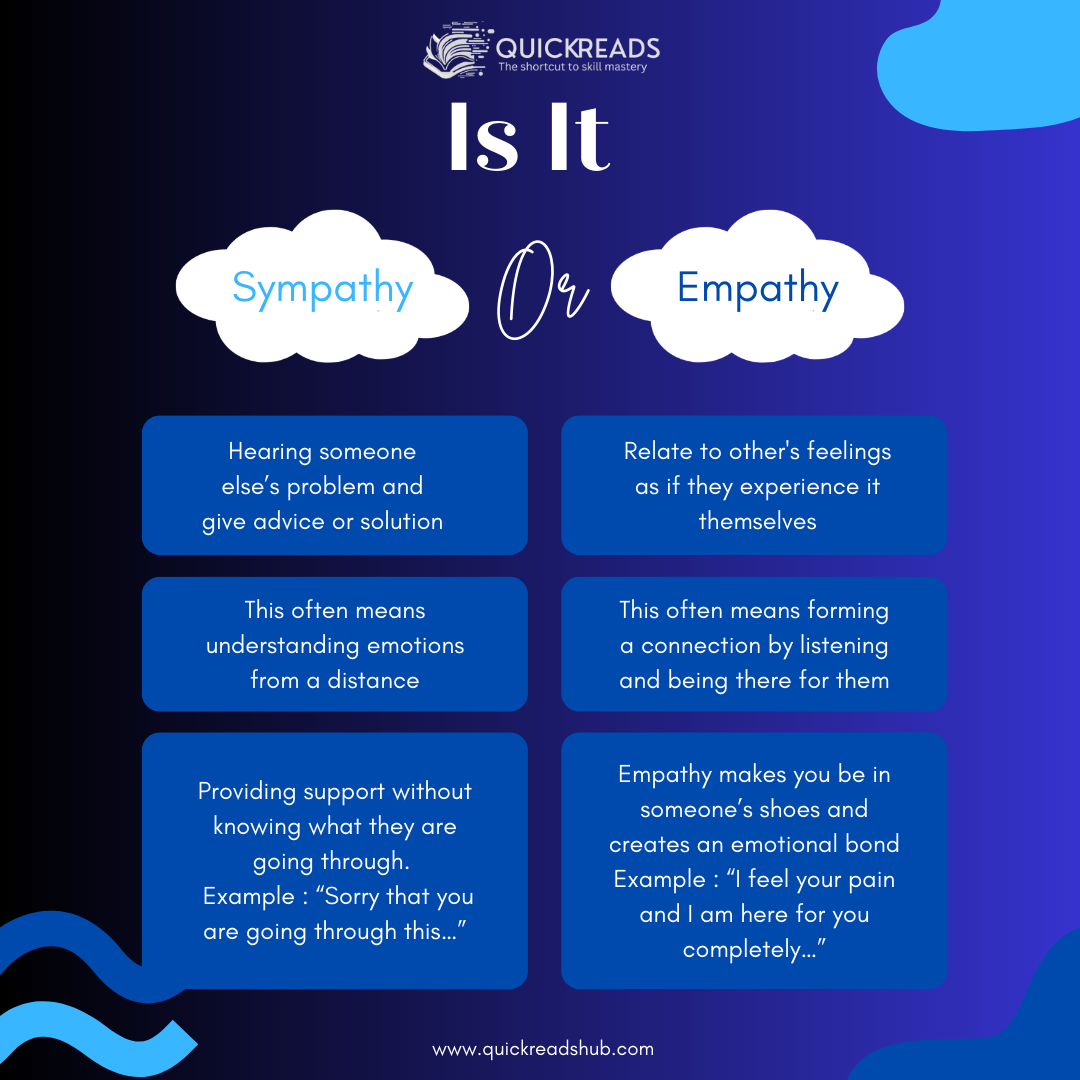In the dynamic world of leadership, one question often arises – “what is empathy in leadership?” Empathy, an often-underestimated trait, is the ability to understand and share the feelings of others. It’s like walking a mile in someone else’s shoes, feeling their joy, their pain, their hopes, and their fears.
While in the context of leadership, empathy takes on a profound significance. It’s not just about understanding your team’s perspective; it’s about leveraging that understanding to drive better results, foster a positive work environment, and ultimately, lead more effectively.
Why is empathy so crucial in leadership? The answer lies in the human element of any organization. Your team is not just a group of employees; they are individuals with unique experiences, aspirations, and challenges. By understanding and acknowledging these, you can unlock a level of trust and collaboration that can propel your team to new heights.
In the following sections, we will delve deeper into the concept of empathy in leadership, exploring its benefits, its implementation, and its impact on the workplace.
Understanding Empathy in Leadership
Empathy is more than just a buzzword. It’s a transformative quality that can drive meaningful change in organizations. Empathy in leadership is about understanding and sharing the feelings of others. It’s about stepping into their shoes and seeing the world from their perspective. This understanding is not just about being nice; it’s about fostering a deeper connection that can lead to more effective leadership and a more cohesive team.
Empathy in leadership is like a bridge, connecting leaders to their team members on a deeper, more personal level. It’s about recognizing your team’s emotions, needs, and concerns, and using that understanding to guide your actions and decisions. It’s about creating a work environment where everyone feels heard, understood, and valued.
Definition of Empathy in Leadership
So, what is empathy in leadership? It’s the ability of a leader to step into the shoes of their team members, feel their emotions, understand their perspectives, and use this understanding to guide their actions. It’s about seeing beyond the surface, beyond the professional facade, and recognizing the human behind the role.
Difference Between Empathy and Sympathy

It’s important to distinguish empathy from sympathy. While sympathy is feeling compassion for someone’s situation, empathy goes a step further. It’s about sharing their feelings, experiencing their challenges as if they were yours. In leadership, this difference is crucial. Sympathy might make you a kind leader, but empathy makes you an effective one.
The Role of Empathy in the Workplace
Now, let’s explore the role of empathy in the workplace. Empathy in leadership is like the secret sauce that makes everything better. It fosters trust, promotes open communication, and builds strong relationships. When leaders demonstrate empathy, they create an environment where employees feel valued and understood. This leads to increased job satisfaction, higher productivity, and a stronger commitment to the organization.
In the next sections, we’ll delve deeper into the benefits of empathetic leadership, how to cultivate it, and its impact on various aspects of the workplace.
The Importance of Empathy in Leadership
Empathy in leadership is not just a soft skill, it’s a critical tool that can drive business success. It’s the golden thread that weaves through every aspect of leadership, from decision-making to problem-solving, team-building, and innovation. But what makes empathy so crucial in leadership? Let’s delve into that.
The Effects of Empathy on Job Performance
Empathy in leadership can have a profound impact on job performance. When leaders demonstrate empathy, they create an environment where employees feel understood and valued. This, in turn, can lead to increased motivation and commitment, driving up job performance. For instance, consider a leader who takes the time to understand an employee’s circumstances that might be affecting their work. By showing empathy, the leader can work with the employee to find solutions, ultimately improving their job performance.
How Empathy Contributes to Positive Outcomes in the Workplace
Empathy also plays a pivotal role in fostering positive outcomes in the workplace. An empathetic leader can create a culture of trust and openness, where employees feel comfortable sharing their ideas and concerns. This can lead to increased collaboration, innovation, and problem-solving. Moreover, empathy can help reduce workplace conflicts. By understanding and acknowledging the feelings and perspectives of others, leaders can help mediate disputes and find solutions that satisfy all parties involved.
The Role of Empathy in Innovation and Retention
Finally, empathy in leadership is critical to driving innovation and employee retention. When employees feel their leaders understand and care about them, they are more likely to feel engaged and committed to the organization. This can lead to lower turnover rates, saving the company the costs of hiring and training new employees. Furthermore, an empathetic work environment can foster creativity and innovation. When employees feel safe and supported, they are more likely to take risks and think outside the box, leading to innovative ideas and solutions.
Empathy in leadership is not just about being nice. It’s about understanding and addressing the needs and feelings of others to create a positive, productive work environment. It’s about building relationships based on trust and respect, which can drive success in any organization. So, the next time you ask yourself, “What is empathy in leadership?”, remember that it’s a vital tool for effective leadership.
6 Traits of an Empathetic Leader
Empathetic leadership is an art that requires a unique blend of skills. It’s not just about understanding the feelings of others, but also about responding in a way that validates their experiences and fosters a supportive environment. So, what are the traits that make an empathetic leader? Let’s explore.

1. Active Listening
Active listening is a cornerstone of empathetic leadership. It’s not just about hearing the words that are being said, but also understanding the underlying emotions and intentions. An empathetic leader listens with the intent to understand, not just to reply. They pay attention to non-verbal cues and ask follow-up questions to gain a deeper understanding. This shows the team members that their leader genuinely cares about their thoughts and feelings, which in turn builds trust and strengthens relationships.
2. Emotional Intelligence
Emotional intelligence is the ability to recognize, understand, and manage our own emotions and the emotions of others. It’s a crucial trait for empathetic leaders. They are not only aware of their own emotional states but can also pick up on the emotions of their team members. This allows them to respond appropriately to different situations, whether it’s offering support during challenging times or celebrating successes.
3. Compassion
Compassion is a fundamental trait of empathetic leaders. It’s about showing genuine concern for the well-being of others. Compassionate leaders are not just focused on the bottom line; they care about their team members as individuals. They understand that everyone has their own struggles and challenges, and they strive to create a supportive environment where everyone feels valued and cared for.
4. Flexibility
Empathetic leaders are flexible. They understand that everyone is unique and that a one-size-fits-all approach doesn’t work. They are willing to adapt their leadership style to meet the needs of their team members. This flexibility allows them to effectively lead diverse teams and foster an inclusive environment where everyone feels heard and respected.
5. Authenticity
Authenticity is about being genuine and true to oneself. Authentic leaders are not afraid to show their true selves, including their strengths and vulnerabilities. They don’t hide behind a facade or try to be someone they’re not. This authenticity builds trust and encourages others to be authentic as well.
6. Good Communication Skills
Good communication is key to effective leadership. Empathetic leaders are skilled communicators. They express their thoughts and feelings clearly and respectfully. They also encourage open communication within the team, creating a safe space where everyone feels comfortable sharing their ideas and concerns.
Empathetic leadership is about more than just understanding the feelings of others. It’s about demonstrating through actions that you genuinely care about your team members. By embodying these traits, you can foster a supportive and inclusive environment where everyone feels valued and heard. Remember, “What is empathy in leadership” is not just a question, but a call to action for all leaders.
The Impact of Empathetic Leadership
Empathy in leadership is not just a soft skill or a nice-to-have trait. It’s a powerful tool that can significantly impact various aspects of an organization, from employee engagement and retention to team dynamics and overall business success. Let’s delve into these areas to understand the profound influence of empathetic leadership.
How Empathy Affects Employee Engagement and Retention
Have you ever worked under a leader who seemed to understand your feelings and perspectives? If so, you probably felt more engaged and committed to your work. Research supports this experience, indicating that empathetic leadership can increase employee engagement. When leaders show genuine care and understanding, employees feel valued and are more likely to stay with the company. This is particularly important in today’s competitive job market, where retaining top talent can be challenging.
The Influence of Empathy on Team Dynamics and Productivity
Empathy plays a crucial role in fostering positive team dynamics. An empathetic leader can create an environment where team members feel safe to express their ideas and concerns, leading to better collaboration and problem-solving. Moreover, when employees feel understood and respected, they are likely to be more productive. It’s like a well-oiled machine, where every part works in harmony, leading to greater efficiency and output.
The Correlation Between Empathetic Leadership and Business Success
Finally, let’s talk about the bottom line. Some might think that empathy is too ‘soft’ a skill to have any real impact on hard business outcomes. But they’d be wrong. Studies have shown a direct correlation between empathetic leadership and business success. Companies with empathetic leaders often outperform their competitors, as they are better able to innovate, adapt to changes, and retain top talent. So, if you’re aiming for business success, developing empathy as a leadership skill is not just a good idea—it’s a strategic move.
Empathetic leadership can have a profound impact on an organization. It affects employee engagement, shapes team dynamics, and contributes to business success. So, when we ask, “What is empathy in leadership?” we can see that it’s a powerful tool that can drive positive outcomes on multiple levels.
The Impact of Empathetic Leadership
Empathy in leadership is not just a soft skill or a nice-to-have trait. It’s a powerful tool that can significantly impact various aspects of an organization, from employee engagement and retention to team dynamics and overall business success. Let’s delve into these areas to understand the profound influence of empathetic leadership.
How Empathy Affects Employee Engagement and Retention
Have you ever worked under a leader who seemed to understand your feelings and perspectives? If so, you probably felt more engaged and committed to your work. Research supports this experience, indicating that empathetic leadership can increase employee engagement. When leaders show genuine care and understanding, employees feel valued and are more likely to stay with the company. This is particularly important in today’s competitive job market, where retaining top talent can be challenging.
The Influence of Empathy on Team Dynamics and Productivity
Empathy plays a crucial role in fostering positive team dynamics. An empathetic leader can create an environment where team members feel safe to express their ideas and concerns, leading to better collaboration and problem-solving. Moreover, when employees feel understood and respected, they are likely to be more productive. It’s like a well-oiled machine, where every part works in harmony, leading to greater efficiency and output.
The Correlation Between Empathetic Leadership and Business Success
Finally, let’s talk about the bottom line. Some might think that empathy is too ‘soft’ a skill to have any real impact on hard business outcomes. But they’d be wrong. Studies have shown a direct correlation between empathetic leadership and business success. Companies with empathetic leaders often outperform their competitors, as they are better able to innovate, adapt to changes, and retain top talent. So, if you’re aiming for business success, developing empathy as a leadership skill is not just a good idea—it’s a strategic move.
Empathetic leadership can have a profound impact on an organization. It affects employee engagement, shapes team dynamics, and contributes to business success. So, when we ask, “What is empathy in leadership?” we can see that it’s a powerful tool that can drive positive outcomes on multiple levels.
How to Foster Empathy in Leadership?
One of the most powerful tools at your disposal is empathy. But how do we foster this trait in a leadership role? The answer lies in understanding and addressing the needs and feelings of your team. This section offers golden nuggets on how to cultivate empathy in leadership, a quality that drives positive change and unlocks the full potential of your team.
Recognizing and Addressing Signs of Burnout
Burnout is a state of emotional, physical, and mental exhaustion caused by excessive and prolonged stress. It occurs when you feel overwhelmed, emotionally drained, and unable to meet constant demands. As a leader, it’s crucial to recognize the signs of burnout in your team members. These may include decreased productivity, increased absenteeism, and a negative attitude toward work. Addressing these signs early can prevent further deterioration of their mental health and job performance.
Showing Sincere Interest in the Needs, Hopes, and Dreams of Others
Empathetic leaders genuinely care about their team members. They take the time to understand their needs, hopes, and dreams. This could be as simple as asking about their weekend or as profound as understanding their career aspirations. By showing sincere interest, you’re not only fostering a deeper connection but also building a supportive work environment where everyone feels valued.
Demonstrating a Willingness to Help Employees with Personal Problems
Life doesn’t stop when we step into the office. Personal problems can affect our work performance and overall well-being. Empathetic leaders understand this. They are willing to lend a listening ear and offer help when their team members are dealing with personal issues. This doesn’t mean solving their problems for them, but rather offering support and understanding during tough times.
Showing Compassion When Others Disclose a Personal Loss
Loss is a part of life, and everyone experiences it differently. When a team member discloses a personal loss, an empathetic leader responds with compassion and understanding. They offer their condolences, give the person space to grieve, and provide support in any way they can. This could be offering time off, providing resources for grief counseling, or simply being there to listen.
By fostering empathy in leadership, we can create a work environment where everyone feels understood, valued, and supported. This not only benefits individual team members but also contributes to the overall success of the organization. Remember, empathy in leadership isn’t just about understanding others’ feelings—it’s about responding to those feelings with compassion and care.
Remember to always keep the balance between being a leader and being a friend. It’s important to maintain professional boundaries while also being empathetic and understanding. Empathy in leadership is about recognizing emotions and responding appropriately, not about becoming emotionally entangled in your team members’ personal lives.
Practical Tips to Foster Empathy in Your Leadership Role
Empathy is not a trait that you either have or don’t have; it’s a skill that can be developed and honed. As a leader, fostering empathy in your leadership role is a golden opportunity to build stronger relationships with your team, promote a positive workplace culture, and ultimately, drive business success. Here are some practical tips and real-world examples to help you foster empathy in your leadership role.
Be Present and Attentive
Being present means fully focusing on the person you’re interacting with, without distractions. It’s about giving them your undivided attention and showing genuine interest in what they’re saying. For instance, during a one-on-one meeting with a team member, avoid checking your phone or computer. Instead, maintain eye contact and respond appropriately to show that you’re fully engaged in the conversation.
Practice Active Listening
Active listening is a key component of empathy. It involves not just hearing the words that another person is saying, but also understanding the complete message being sent. For example, if a team member is expressing concern about a project deadline, don’t just acknowledge their worry. Instead, ask follow-up questions to understand the root of their concern and discuss potential solutions.
Show Genuine Interest in Others
Showing genuine interest in others goes beyond the workplace. It involves recognizing that your team members have lives outside of work and showing interest in their personal experiences and interests. For example, if a team member shares that they ran a marathon over the weekend, take the time to ask about their experience and congratulate them on their achievement.
Encourage Open Communication
Fostering empathy in leadership also involves promoting an environment where team members feel comfortable expressing their thoughts and feelings. This can be achieved by encouraging open communication and ensuring that everyone feels heard. For example, during team meetings, make sure to give everyone the opportunity to speak and share their ideas.
Lead by Example
As a leader, your actions set the tone for the rest of the team. Demonstrating empathy in your interactions can inspire your team members to do the same. For instance, if a team member makes a mistake, instead of reprimanding them, use it as a learning opportunity. Discuss what went wrong, and how it can be avoided in the future, and reassure them that it’s okay to make mistakes.
Remember, fostering empathy in leadership is not a one-time effort, but a continuous process. By incorporating these tips into your leadership style, you can cultivate a more empathetic and effective leadership approach.
Further Reading: Books to Enhance Your Leadership Empathy
If you’re interested in diving deeper into the concept of empathy in leadership, there are several insightful books that can provide you with a wealth of knowledge and practical strategies. Here are a few recommendations:
Emotional Intelligence: Why It Can Matter More Than IQ by Daniel Goleman
Daniel Goleman’s groundbreaking book explores the concept of emotional intelligence, including empathy, and its profound impact on leadership and personal success. It’s a must-read for anyone looking to understand and improve their emotional intelligence.
Dare to Lead: Brave Work. Tough Conversations. Whole Hearts. by Brené Brown
In this book, Brené Brown shares her research on leadership and offers practical strategies for leading with empathy and courage. It’s a great resource for leaders looking to foster a culture of empathy and vulnerability in their teams.
The Empathy Edge: Harnessing the Value of Compassion as an Engine for Success by Maria Ross
Maria Ross makes a compelling case for why empathy is crucial for business success. She provides practical tips and real-world examples of how leaders can cultivate empathy to drive growth, innovation, and employee engagement.
The Art of Empathy: A Complete Guide to Life’s Most Essential Skill by Karla McLaren
Karla McLaren’s book offers a comprehensive guide on how to develop and use empathy in everyday life, including in leadership roles. It’s a valuable resource for anyone looking to enhance their empathetic skills.
Related Blogs:
- Surprisingly Powerful Best Empathy Leadership Style
- Leadership in Turbulent Times book summary and insights
- Remote Leadership Communication: 5 Ways To Improve and Apply
- Remote Work And Mental Health Unlocking Ways To Be Outstanding
- Good Leadership Qualities On How to Become the Leader Everyone Admires
Remember, reading about empathy is just the first step. Applying what you learn to your leadership style is what will truly make a difference. Happy reading!
Conclusion
As we wrap up our discussion on “what is empathy in leadership,” it’s clear that empathy plays a pivotal role in effective leadership. It’s not just about understanding the emotions and perspectives of others, but also about responding in a way that benefits both the individual and the organization.
Empathy in leadership is about more than just being nice. It’s about understanding the needs, hopes, and dreams of your team members. It’s about creating a work environment where everyone feels valued and heard. It’s about fostering a culture of trust, respect, and open communication.
The importance of empathy in leadership cannot be overstated. It affects job performance, contributes to positive outcomes in the workplace, and plays a significant role in innovation and retention. Leaders who exhibit empathy are more likely to have engaged and productive teams.
So, as a leader, how can you cultivate empathy? Start by recognizing and addressing signs of burnout in your team. Show sincere interest in the needs, hopes, and dreams of your team members. Demonstrate a willingness to help employees with personal problems, and show compassion when others disclose a personal loss.
Remember, empathy is not a trait that you either have or don’t have. It’s a skill that can be developed and improved over time. So, take the time to practice empathy in your leadership role. Your team, and your organization, will be better for it.
FAQs
Q: Why is empathy important in leadership?
A: Empathy is crucial in leadership because it allows leaders to understand and share the feelings of their team members. This understanding fosters a supportive and inclusive work environment, leading to increased job satisfaction, improved team collaboration, and ultimately, higher productivity. Empathetic leaders can better address their team’s needs and concerns, leading to more effective problem-solving and decision-making.
Q: What is an example of empathetic leadership?
A: An example of empathetic leadership can be seen in a leader who takes the time to listen to their team members’ ideas and concerns, validates their feelings, and takes action to address any issues. This could be a manager who rearranges project deadlines after understanding the workload stress on a team member, or a CEO who implements flexible working hours after recognizing the diverse personal needs of their employees.
Q: What are the 3 skills of empathy?
A: The three skills of empathy are:
- Perspective-taking: This is the ability to see a situation from another person’s point of view. It involves understanding their thoughts, feelings, and motivations.
- Non-judgmental listening: This involves listening to others without forming preconceived notions or judgments. It’s about being open and accepting of the other person’s experience.
- Communicating understanding: This is the ability to convey to others that you understand their feelings and perspectives. It involves acknowledging their emotions and expressing that you understand their experience.
Q: What is the power of empathy in leadership?
A: The power of empathy in leadership lies in its ability to build strong, trusting relationships within a team. When leaders demonstrate empathy, they show their team members they are valued and understood. This can lead to increased morale, higher job satisfaction, and improved performance. Empathetic leadership also fosters a culture of open communication, where team members feel comfortable sharing their ideas and concerns, leading to more effective problem-solving and innovation.





